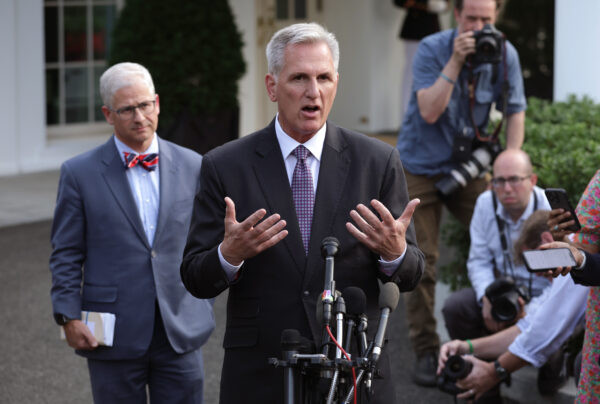
Treasury Secretary Janet Yellen reiterated her projection that the U.S. debt ceiling default deadline is still early June, when her department might exhaust the extraordinary measures employed since January.
Yellen confirmed at a virtual Wall Street Journal CEO Summit on May 24 that she would soon update Congress about government finances, adding that payment prioritization is not operationally feasible and that the Treasury will be unable to cover some of the obligations on them following the so-called X-date.
“It’s highly likely that we would run out of resources to meet all the government’s obligations in early June and possibly as early as June 1,” she said. “We no longer see very much likelihood that our resources will enable us to get to the middle or end of June.”
The stress she is observing in the financial markets, especially in bonds, “should be a reminder of the importance of reaching a timely agreement,” she said. Despite growing concerns that both sides will let the country default, Yellen believes that a debt limit agreement can still be reached between the White House and House Republicans.
“We simply have to raise the debt ceiling,” Yellen stated.
According to the Daily Treasury Statement, the Treasury’s opening cash balance on May 22 was $60.656 billion, down 80 percent from the beginning of the month at $316.381 billion.
There has been some skepticism surrounding Yellen’s June 1 deadline, with several House Republicans urging the Treasury secretary to offer proof of her claims.
But House Speaker Kevin McCarthy (R-Calif.) has accepted the June 1 deadline.


In a May 22 letter to the congressional leadership, Yellen conceded that it is “impossible” to provide an exact date when the Treasury can no longer pay the federal government’s bills. But she assured McCarthy that it is “highly likely” that the Treasury will be unable to “satisfy all of the government’s obligations” if Congress fails to raise or suspend the debt limit by early June.
Rep. Garret Graves (R-La.), who has been the lead Republican negotiator on getting a debt ceiling deal, told reporters on May 23 that he cannot call Yellen’s forecasts into question.
Rep. Patrick McHenry (R-N.C.), the chair of the House Financial Services Committee, also accepted the June 1 deadline, alluding to her “varied economic experience” and that she is a “straight shooter.” He confirmed that Yellen would appear before the panel on June 7, just days following the potential X-date.
With only days to avoid a default on the nation’s credit, Sen. Bernie Sanders (I-Vt.) wrote in a Fox News op-ed that President Joe Biden must invoke the 14th Amendment.
“This is not a radical idea. Making sure that the United States continues to pay its bills regardless of whether the statutory increase in the debt ceiling is raised or not is an idea that has been supported by Republicans and Democrats,” he said.
“It must be exercised.”
But critics have purported that the prospect of invoking the 14th Amendment could result in economic uncertainty since the action would likely be challenged before the Supreme Court.
In front of reporters, Graves called it an “absurd” proposal.
The Bipartisan Policy Center (BPC) thinks the X-date could fall between June 2 and June 13. But nearing this date could trigger the worst-case scenarios.
“Come early June, Treasury will be skating on very thin ice that will only get thinner with each passing day. Of course, the problem with skating on thin ice is that sometimes you fall through,” said Shai Akabas, executive director of BPC’s Economic Policy Program, in a statement. “The longer policymakers wait to address the debt limit, the more likely our economic fate will be determined by external actors.”
A team of economists at Capital Economics stated that the immediate short-term concern in the financial markets is the debt ceiling crisis, citing rising credit default swaps and the gap between short-dated Treasury bill yields and other interest rates.
“That leaves ample room for a sell-off if Congress leaves the debt ceiling decision until the very last minute, risking an accident,” they wrote in a note.
The one-month Treasury yield touched an all-time high of 5.88 percent on May 22 before sliding back to 5.722 percent. The yield on the benchmark 10-year yield was flat at around 3.7 percent.
Arthur Laffer Jr., the president of Laffer Tengler Investments, anticipates that the debt ceiling drama could cause the White House to “force the shutdown of non-essential services to conserve spending in order to get public opinion against Congress.”
“It is far easier to put pressure on a handful of swing congressional votes than sway just one person. For better or worse we expect a fight with the U.S. taxpayer paying the bill as always,” he wrote.
Even if the government fails to make a single U.S. Treasury bond interest payment, there could be a risk of “contaminating the entire U.S. Treasury product,” ING economists warned.
“That risks taking down the system. It’s highly unlikely to happen. But mistakes can be made,” they said in a research note.
But a default could trigger a “crisis of confidence” and result in more restrictive lending conditions, leading to a recession.
“Recession risks would be heightened which would push unemployment higher and lead to a more rapid fall in inflation, opening the door to even more aggressive interest rate cuts from the Federal Reserve than we are currently forecasting,” the ING economists wrote.
Yellen also told the event that she believes tight labor markets will continue to push up core inflation. At the same time, stabilizing apartment rents could help trim the core inflation rate.
In April, the annual core consumer price index, which strips the volatile energy and food components, ticked lower to 5.5 percent, down from 5.6 percent in March. The rent of shelter remained elevated at 8.2 percent and climbed 0.5 percent month-over-month.
The Federal Reserve has insisted that rent is a lagging inflation indicator, and recent trends suggest that the worst is over. However, the Zillow Observed Rent Index increased 0.6 percent month-over-month in April, the sharpest jump since August 2022, to $2,018.
Jackson Richman contributed to this report.




Discount Applied Successfully!
Your savings have been added to the cart.